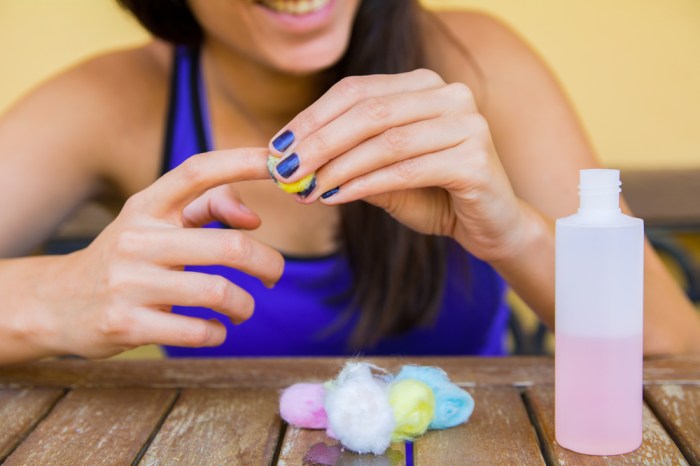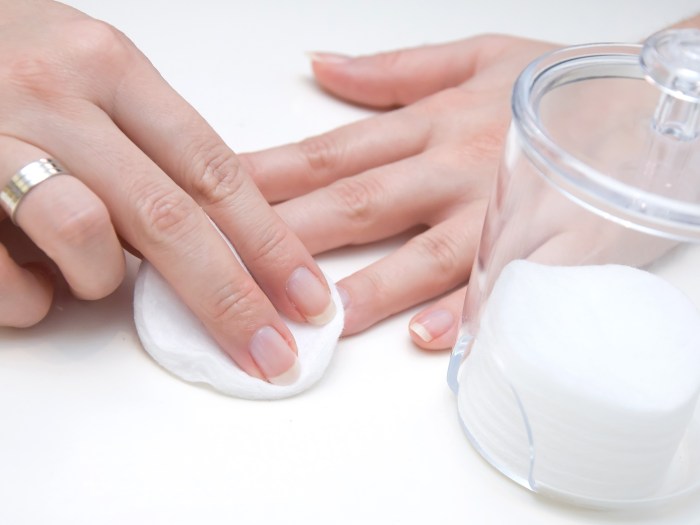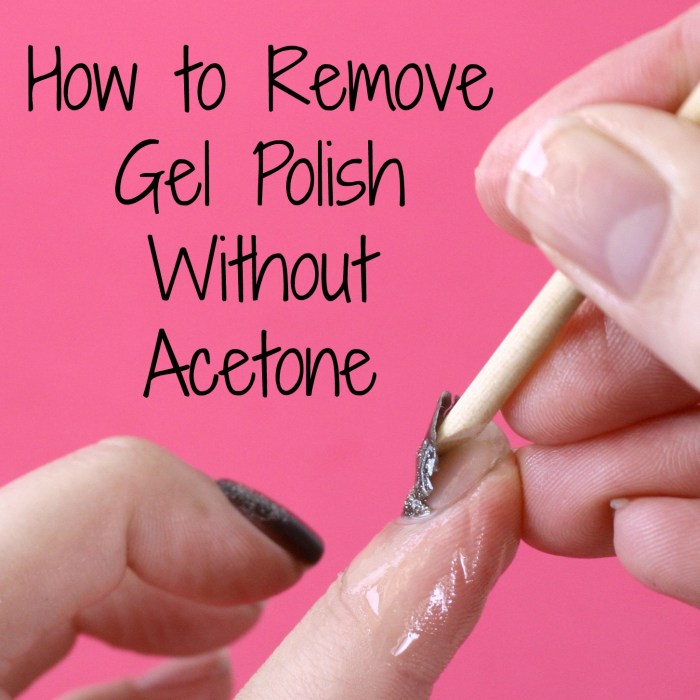How Can You Make Nail Polish Remover?
Understanding Nail Polish Remover Ingredients
How can you make nail polish remover – Nail polish remover’s effectiveness hinges on its chemical composition. Understanding the role of each ingredient is crucial for choosing a remover that’s both effective and safe for your nails and the environment.
Chemical Composition of Common Nail Polish Removers
Most nail polish removers are primarily composed of solvents, often acetone or ethyl acetate, which dissolve the nail polish. They may also contain emollients to condition the nails and fragrances to mask the strong odor of the solvents. Some removers include added moisturizers like vitamin E or oils.
The Role of Each Ingredient in the Removal Process
The solvent is the key active ingredient, responsible for breaking down the polymer chains in nail polish. Emollients help to soften and protect the nails, preventing dryness and brittleness. Fragrances simply add a pleasant scent.
Comparison of Solvents Used in Nail Polish Removers
Acetone is a powerful solvent, known for its rapid and effective nail polish removal. However, it can be harsh on nails and dry them out. Ethyl acetate is a gentler alternative, though it may take slightly longer to remove polish. Other solvents, like isopropyl alcohol, are less commonly used.
Acetone-Based vs. Acetone-Free Nail Polish Removers
| Feature | Acetone-Based | Acetone-Free |
|---|---|---|
| Effectiveness | Very effective, fast removal | Less effective, slower removal |
| Nail Health | Can dry out and weaken nails | Generally gentler on nails |
| Odor | Strong, pungent odor | Milder odor |
| Cost | Generally less expensive | Often more expensive |
Homemade Nail Polish Remover Recipes
Creating your own nail polish remover allows for greater control over ingredients and can be a more environmentally conscious choice. However, it’s crucial to follow safety precautions carefully.
Three Homemade Nail Polish Remover Recipes
While precise ratios may vary depending on desired strength and ingredient availability, here are three basic recipes:
- Recipe 1 (Ethyl Acetate-Based): Combine 1 part ethyl acetate (available at some pharmacies or online) with 2 parts moisturizing oil (like jojoba or olive oil).
- Recipe 2 (Alcohol-Based): Mix equal parts isopropyl alcohol (rubbing alcohol) and water. Add a few drops of essential oil for fragrance (optional).
- Recipe 3 (Acetone-Free, gentler): Combine 2 parts pure acetone-free nail polish remover (check labels carefully) with 1 part nourishing oil (e.g., sweet almond oil).
Safety Precautions for Handling Homemade Remover Ingredients
Always work in a well-ventilated area when handling solvents. Avoid contact with eyes and skin. Keep away from flames and sources of ignition. Properly label containers and store them out of reach of children.
Homemade vs. Commercial Nail Polish Remover Effectiveness
Homemade removers may be less effective than commercially available ones, especially those containing acetone. The effectiveness will largely depend on the ingredients used and their concentration. Homemade removers are often gentler on nails, but may require more time and effort for complete polish removal.
Step-by-Step Guide for Making an Ethyl Acetate-Based Remover
- Gather your ingredients: ethyl acetate, moisturizing oil, and a clean, empty container with a tight-fitting lid.
- Measure the ethyl acetate and oil according to the recipe (1:2 ratio).
- Carefully pour the ingredients into the container.
- Securely close the lid and gently shake the mixture until well combined.
- Label the container clearly with the contents and date.
The Process of Nail Polish Removal
Understanding the chemical process and proper technique is key to effective and safe nail polish removal. This minimizes damage to nails and promotes healthy nail growth.
Chemical Reaction During Nail Polish Removal
The solvent in the remover dissolves the polymer matrix of the nail polish, breaking down its structure and allowing it to be easily wiped away. This is a dissolution process, not a chemical reaction in the traditional sense.
Proper Technique for Using Nail Polish Remover

Source: womensalphabet.com
Apply remover to a cotton ball or pad, gently pressing it against the nail for a few seconds to soften the polish. Wipe gently from the base to the tip of the nail, avoiding harsh scrubbing. Avoid prolonged contact with the skin.
Creating your own nail polish remover is surprisingly straightforward, often involving readily available ingredients like acetone or ethyl acetate. However, if you’re looking for a way to remove a particularly stubborn polish, such as a crackle nail polish black finish, you might need a more potent solution. Experimenting with different ratios of solvents can help you achieve the perfect balance for your needs, ensuring effective and gentle removal.
Remember to always test on a small area first before applying to the entire nail.
Impact of Different Application Methods
Soaked cotton pads are generally more effective for stubborn polish, but prolonged soaking can dry out nails. Cotton balls allow for more control but may require more effort. Using a gentler remover and less friction is always preferable for nail health.
Steps Involved in a Complete Manicure (Including Nail Polish Removal)
- Prepare the nails by removing any old polish.
- Shape and file the nails.
- Cuticle care (push back or trim cuticles).
- Apply a base coat.
- Apply two coats of nail polish, allowing each to dry completely.
- Apply a top coat.
Environmental Considerations
The environmental impact of nail polish remover is significant, primarily due to the solvents used. Choosing eco-friendly alternatives minimizes this impact.
Environmental Impact of Nail Polish Remover Ingredients
Acetone and ethyl acetate are volatile organic compounds (VOCs) that contribute to air pollution. Their disposal also presents environmental challenges. Some removers contain other potentially harmful chemicals.
Environmentally Friendly Alternatives
Water-based removers, those using plant-derived solvents, or removers with minimal or no added fragrances are better choices. Refillable containers also reduce waste.
Cost-Effectiveness of Eco-Friendly Options
Eco-friendly removers are often more expensive than conventional ones, but the long-term benefits for the environment and potentially for nail health may outweigh the higher initial cost.
Environmental Impact Comparison of Solvents

Source: wikihow.com
| Solvent | Environmental Impact | Biodegradability | Toxicity |
|---|---|---|---|
| Acetone | High VOC emissions | Low | Moderate |
| Ethyl Acetate | Moderate VOC emissions | Moderate | Low |
| Isopropyl Alcohol | Moderate VOC emissions | High | Low |
| Water-based | Low | High | Very Low |
Safety Precautions and Handling: How Can You Make Nail Polish Remover
Proper handling and storage of nail polish remover are crucial to prevent accidents and health problems. Always prioritize safety when working with these chemicals.
Safety Measures for Handling and Using Nail Polish Remover

Source: whatthegelnails.com
Always use nail polish remover in a well-ventilated area to avoid inhaling fumes. Avoid prolonged or direct skin contact. Keep away from eyes and open flames. Wash hands thoroughly after use.
Potential Health Risks Associated with Prolonged Exposure, How can you make nail polish remover
Prolonged exposure to nail polish remover fumes can cause respiratory irritation, headaches, dizziness, and in some cases, more serious health problems. Skin contact can lead to dryness, irritation, or allergic reactions.
Safe Storage and Disposal
Store nail polish remover in a cool, dry place away from direct sunlight and heat. Dispose of it according to local regulations. Never pour it down the drain.
Safety Data Sheet (SDS) Summary for Acetone
- Hazard Classification: Flammable liquid and vapor, irritant.
- Precautions: Keep away from heat/sparks/open flames/hot surfaces. No smoking. Use only outdoors or in a well-ventilated area. Wear protective gloves/eye protection/face protection.
- First Aid: In case of eye contact, rinse cautiously with water for several minutes. Remove contact lenses, if present and easy to do. Continue rinsing. If skin irritation occurs: Get medical advice/attention. If inhaled: Remove person to fresh air and keep comfortable for breathing.
Key Questions Answered
Can I use rubbing alcohol instead of acetone?
Rubbing alcohol (isopropyl alcohol) can dissolve some nail polishes, but it’s generally less effective than acetone and may require more time and effort.
How long does homemade nail polish remover last?
The shelf life of homemade remover depends on the ingredients and storage conditions. Store it in a cool, dark place in an airtight container; it may last for several months.
Is it safe to make nail polish remover at home?
While it’s possible to make nail polish remover at home, it’s crucial to follow safety precautions, use proper ventilation, and handle ingredients carefully. Always refer to the safety data sheet for any chemicals used.
What are the best containers to store homemade nail polish remover?
Dark-colored glass bottles with tight-fitting lids are ideal for storing homemade nail polish remover, protecting it from light and preventing evaporation.
















